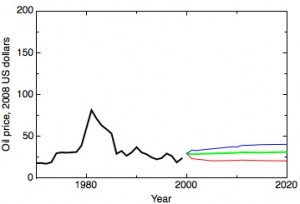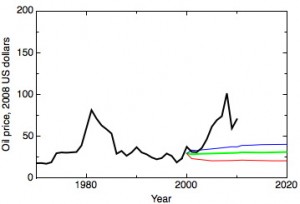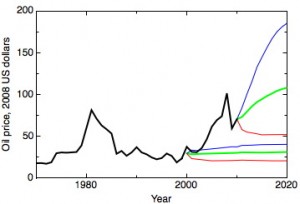When one starts reading about the future of the world’s energy economy, one needs to get used to making conversions amongst a zoo of energy units – exajoules, millions of tons of oil equivalent, quadrillions of british thermal units and the rest. But these conversions are trivial in comparison to a couple of other rates of exchange – the relationship between energy and carbon emissions (using this term as a shorthand for the effect of energy use on the global climate), and the conversion between energy and money.
On the face of it, it’s easy to see the link between emissions and energy. You burn a tonne of coal, you get 29 GJ of energy out and you emit 2.6 tonnes of carbon dioxide. But, if we step back to the level of a national or global economy, the emissions per unit of energy used depend on the form in which the energy is used (directly burning natural gas vs using electricity, for example) and, for the case of electricity, on the mix of generation being used. But if we want an accurate picture of the impact of our energy use on climate change, we need to look at more than just carbon dioxide emissions. CO2 is not the only greenhouse gas; methane, for example, despite being emitted in much smaller quantities than CO2, is still a significant contributor to climate change as it is a considerably more potent greenhouse gas than CO2. So if you’re considering the total contribution to global warming of electricity derived from a gas power station you need to account, not just for the CO2 produced by direct burning, but of the effect of any methane emitted from leaks in the pipes getting to the power station. Likewise, the effect on climate of the high altitude emissions from aircraft is substantially greater than that from the carbon dioxide alone, for example due to the production of high altitude ozone from NOx emissions. All of these factors can be wrapped up by expressing the effect of emissions on the climate through a measure of “mass of carbon dioxide equivalent”. It’s important to take these additional factors into account, or you end up significantly underestimating the climate impact of much energy use, but this accounting embodies more theory and more assumptions.
For a high accessible and readable account of the complexities of assigning carbon footprints to all sorts of goods and activities, I recommend Mike Berners-Lee’s new book How Bad Are Bananas?: The carbon footprint of everything. This has some interesting conclusions – his insistence on full accounting leads to surprisingly high carbon footprints for rice and cheese, for example (as the title hints, he recommends you eat more bananas). But carbon accounting is in its infancy; what’s arguably most important now is money.
At first sight, the conversion between energy and money is completely straightforward; we have well-functioning markets for common energy carriers like oil and gas, and everyone’s electricity bill makes it clear how much we’re paying individually. The problem is that it isn’t enough to know what the cost of energy is now; if you’re deciding whether to build a nuclear power station or to install photovoltaic panels on your roof, to make a rational economic decision you need to know what the price of energy is going to be over a twenty to thirty year timescale, at least (the oldest running nuclear power reactor in the UK was opened in 1968).
The record of forecasting energy prices and demand is frankly dismal. Vaclav Smil devotes a whole chapter of his book Energy at the Crossroads: Global Perspectives and Uncertainties to this problem – the chapter is called, simply, “Against Forecasting”. Here are a few graphs of my own to make the point – these are taken from the US Energy Information Administration‘s predictions of future oil prices.
In 2000 the USA’s Energy Information Agency produced this forecast for oil prices (from the International Energy Outlook 2000):

After a decade of relatively stable oil prices (solid black line), the EIA has relatively tight bounds between its high (blue line), low (red line) and reference (green line) predictions. Let’s see how this compared with what happened as the decade unfolded:

The EIA, having been mugged by reality in its 2000 forecasts, seems to have learnt from its experience, if the range of the predictions made in 2010 is anything to go by:

This forecast may be more prudent than the 2000 forecast, but with a variation of nearly of factor of four between high and low scenarios, it’s also pretty much completely useless. Conventional wisdom in recent years argues that we should arrange our energy needs through a deregulated market. It’s difficult to see how this can work when the information on the timescale needed to make sensible investment decisions is so poor.